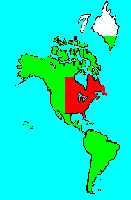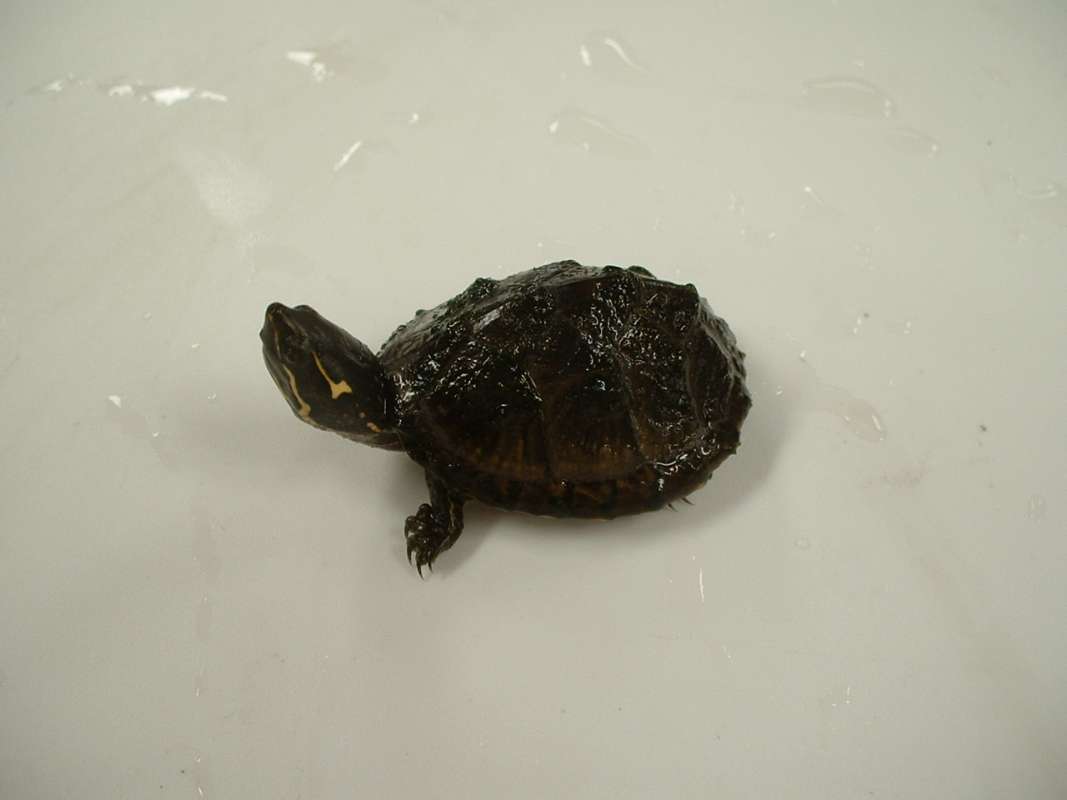SPECIES INFO
Common musk turtle or stinkpot (Sternotherus odoratus) is native to the eastern United States. This species can be found from New England west to southern Wisconsin and all of Illinois, and south from New England to most of the Florida mainland and west to eastern Texas. This turtle has a preference for clear water and walks around on the bottom searching for food.
The two yellow lines on the head (one above and one under the eye) help identify this species. In northern Illinois this turtle rarely suns itself, but warms itself by floating underneath lily pads. Once common in northern Illinois, carp have stirred up and destroyed many of its former habitats. This is normally between 2 and 4 inches long, but examples over 5 inches are known.Musk turtles (genus Sternotherus) have small lower shells (plastons). Although the plastons are hinged the hinge is not very obvious. There are usually barbels on the chin.
Mud and Musk Turtle Group (Family Kinosternidae) is closely related to the snapping turtle group. it is found from Canada south to Ecuador. They usually have very reduced lower shells (plastrons). These turtles are frequently called "stinkpots". They normallly crawl around on the botton of lakes, rivers, and ponds.
Kinosternidae Family in North America contains the following eight species:
SCIENTIFIC NAME - - - COMMON NAME - - GENERAL RANGE
Sternotherus odoratus - (Stinkpot) - East United States
Sternotherus carinatus - (Razor Back Musk)- Louisiana and adjacent
Sternotherus minor - (Loggerhead Musk) - Alabama and north Fla
Kinosternum subrubrum - (Mud Turtle) Eastern Texas, SE United States
Kinosternum baurii - (Striped Mud) Florida
Kinosternum flavescens -( Yellow Mud) Texas to Nebraska
Kinosternum sonoriense - (Sonora Mud) - South New Mexico and S Arizona
Kinosternum hirtipes - (Rough Footed Mud) Big Bend, Texas
Turtle and Tortoise group (Order Chelonia) are among the most primitive reptiles. They are egg-laying creatures characterized by having four legs, a tail, and two shells each made up of many scales that are joined together. There are about two hundred and fifty species of turtles in the world. Carl Ernst and Roger Barbour published a book entitled "Turtles of the World" by the Smithsonian Press in l989. This work covers all of the known species. The authors note that there are two hundred and fifty-seven species of living turtles. Many of these species are pictured and discussed here.
The following overview of the various families included in the Turtle Order is based on the aforementioned publication:
SCIENTIFIC NAME - COMMON NAME - NUMBER OF SPECIES
Pelomedusidae - Side Necked - 23 species
Chelidae - Side Necked - 36 species
Kinosternidae - Mud and Musk - 22 species
Dermatemydidae - River Turtle - 1 species
Carettochelyidae - Pig Nose - 1 species
Trionychidae - Soft Shelled - 22 species
Dermochelyidae - Leatherback - 1 species
Cheloniidae - Sea Turtles - 6 species
Chelydridae - Snapping turtles - 2 species
Platysternidae - Big Headed - 1 species
Emydidae - Pond and Box - 91 species
Testudinidae - Tortoises - 50 species
256 total species
While the above counts are currently reliable, they will be impacted by findings as research continues. For example, the exact count of the species of tortoises in the Galapagos and placement of the Florida Snapping Turtle might change these counts.
Reptiles (Class Reptilia) are an ancient group of scaled chordates. These scales may be permanently joined, as in the turtles, or flexible, as in the snakes. Reptiles are land-based. Their eggs are laid on land and the young are air breathing.
In the Great Big Book of Snakes and Reptiles published in 2014, they noted that there are more than 7,000 species of reptiles alive today.
Backboned Animals (Phylum Chordata) are the most advanced group of animals on earth. These animals are characterized by having a spinal cord or backbone. Most members have a clearly defined brain that controls the organism through a spinal cord. Fish, amphibians, reptiles, birds, and mammals are in this phylum.
Currently, some taxonomists believe that the fish should be divided into two groups (sharks and regular fishes) and that there are some other primitive groups in the phylum such as hagfish or lampreys.
Animal Kingdom contains numerous organisms that feed on other animals or plants. Included in the animal kingdom are the lower marine invertebrates such as sponges and corals, the jointed legged animals such as insects and spiders, and the backboned animals such as fish, amphibians, reptiles, birds, and mammals.



